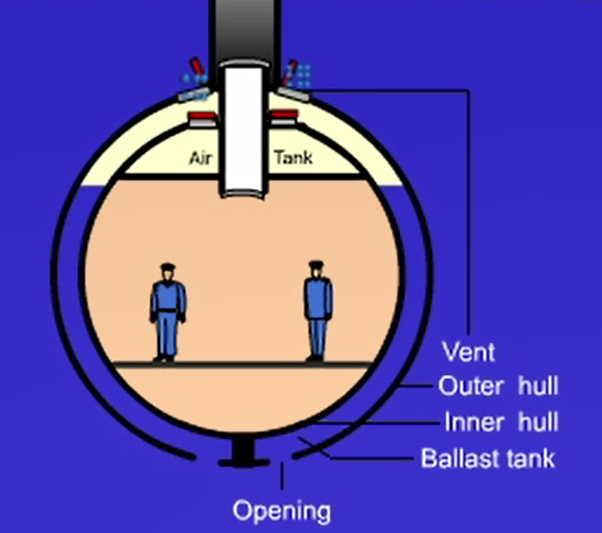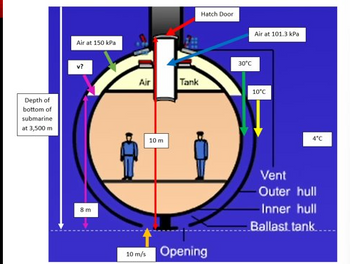When the submarine is on the surface, its ballast tanks are filled with air. As the submarine dives, the ballast tanks are flooded with water and the air in the ballast tanks is vented from the submarine. The submarine descends from sea level and holds at a constant depth of 3,500m. Background Information Submarine Volume is 450 m3 Mass (excluding weight in ballast tank) is 400 tons Outer haul Mass is 40 tons Thickness is 15 cm Exterior surface area is 200 m2 Specific heat capacity is 420 J/kg/K Latent heat of fusion is 250 kJ/kg Temperature at surface (depth of 0 m) is 25°C depth of 3,500 m internal of the outer haul (next to ballast tank) is 10 30°C (Refer to diagram) external of the outer haul is 10°C (Refer to diagram) Thermal conductivity is 80 kW/m/K Emissivity of 0.9 Ballast Tank at a depth of 3,500 m Temperature at is 30°C Seawater Specific gravity of 1.05 Surrounding temperature at a depth of 3,500 m is 4°C Convective heat transfer coefficient for free convection is 75 W/m2/K Question Describe the forces that enable the submarine to descend or ascend in the seawater. When the submarine holds at the constant depth of 3,500m, calculate the buoyant force on the submarine. weight of seawater in the ballast tank. seawater pressure. 3. When seawater flows into the bottom opening at 10 m/s, calculate the velocity of the seawater level (8m above the bottom of the submarine) inside the ballast tank (v on diagram). 4. Calculate the net force on the submarine circular hatch door (10m above the bottom of the submarine) with a radius of 0.5m. The air pressure inside the submarine below the hatch door is 150 101.3 kPa. 5. Calculate the change in heat energy of the submarine’s outer haul, when it descends from the surface to a depth of 3,500m (with an average temperature of 20°C). 6. Calculate the power of the submarine’s electrical heater needed, to maintain the interior of outer hull at 30°C. The exterior of outer hull is 10°C. (Assume heat of the submarine is only lost across the outer hull) 7. Suggest aerospace applications of ballast.
When the submarine is on the surface, its ballast tanks are filled with air. As the submarine dives, the ballast tanks are flooded with water and the air in the ballast tanks is vented from the submarine. The submarine descends from sea level and holds at a constant depth of 3,500m.
Background Information
- Submarine
- Volume is 450 m3
- Mass (excluding weight in ballast tank) is 400 tons
- Outer haul
- Mass is 40 tons
- Thickness is 15 cm
- Exterior surface area is 200 m2
- Specific heat capacity is 420 J/kg/K
- Latent heat of fusion is 250 kJ/kg
- Temperature at
- surface (depth of 0 m) is 25°C
- depth of 3,500 m
- internal of the outer haul (next to ballast tank) is 10 30°C (Refer to diagram)
- external of the outer haul is 10°C (Refer to diagram)
- Thermal conductivity is 80 kW/m/K
- Emissivity of 0.9
- Ballast Tank at a depth of 3,500 m
- Temperature at is 30°C
- Seawater
- Specific gravity of 1.05
- Surrounding temperature at a depth of 3,500 m is 4°C
- Convective heat transfer coefficient for free convection is 75 W/m2/K
Question
- Describe the forces that enable the submarine to descend or ascend in the seawater.
- When the submarine holds at the constant depth of 3,500m, calculate the
- buoyant force on the submarine.
- weight of seawater in the ballast tank.
- seawater pressure.
3. When seawater flows into the bottom opening at 10 m/s, calculate the velocity of the seawater level (8m above the bottom of the submarine) inside the ballast tank (v on diagram).
4. Calculate the net force on the submarine circular hatch door (10m above the bottom of the submarine) with a radius of 0.5m. The air pressure inside the submarine below the hatch door is 150 101.3 kPa.
5. Calculate the change in heat energy of the submarine’s outer haul, when it descends from the surface to a depth of 3,500m (with an average temperature of 20°C).
6. Calculate the power of the submarine’s electrical heater needed, to maintain the interior of outer hull at 30°C. The exterior of outer hull is 10°C. (Assume heat of the submarine is only lost across the outer hull)
7. Suggest aerospace applications of ballast.

Step by step
Solved in 3 steps with 9 images

Can u continue the question 5 to 7
5. Calculate the change in heat energy of the submarine’s outer haul, when it descends from the surface to a depth of 3,500m (with an average temperature of 20°C).
6. Calculate the power of the submarine’s electrical heater needed, to maintain the interior of outer hull at 30°C. The exterior of outer hull is 10°C. (Assume heat of the submarine is only lost across the outer hull)
7. Suggest aerospace applications of ballast.
WHEN SEAWATER FLOWS INTO THE BOTTOM OPENING AT 10 M/S, CALCULATE THE VELOCITY OF THE SEAWATER LEVEL (8M ABOVE THE BOTTOM OF THE SUBMARINE) INSIDE THE BALLAST TANK (V ON DIAGRAM).


